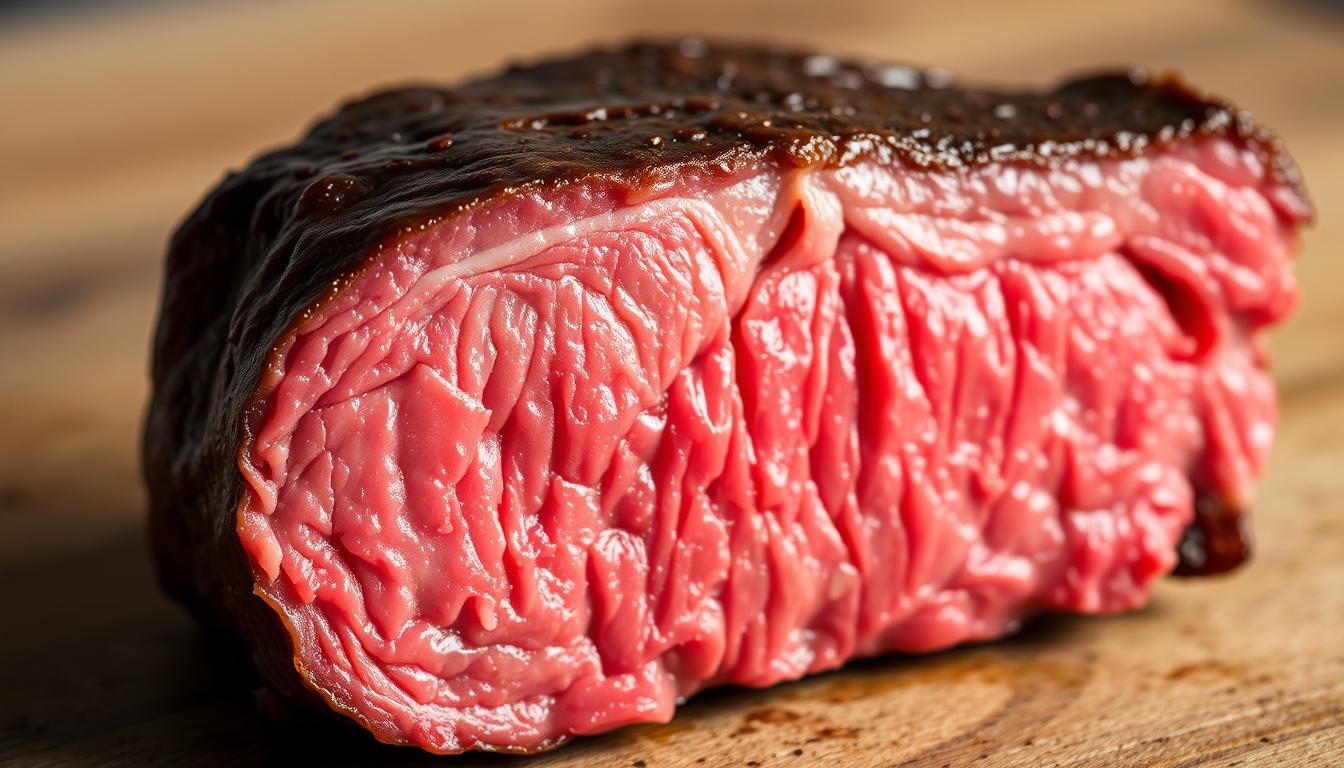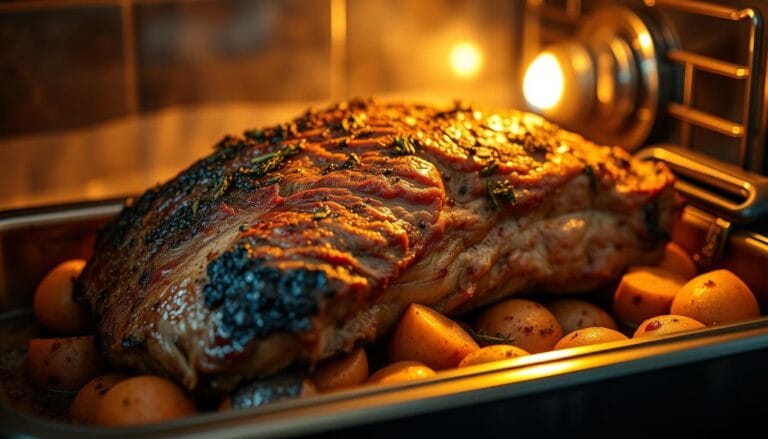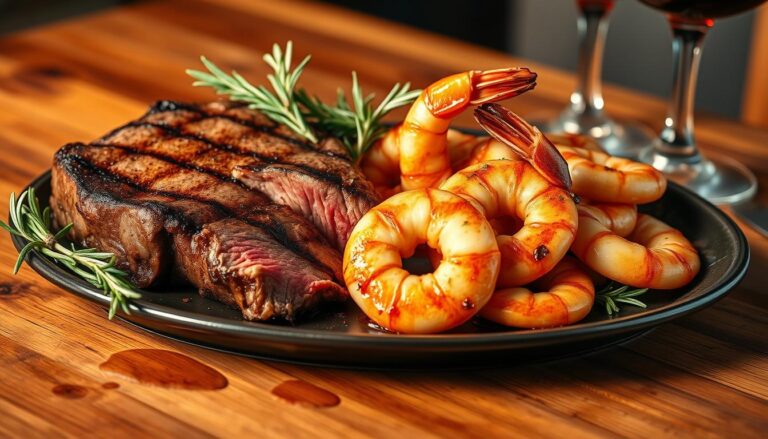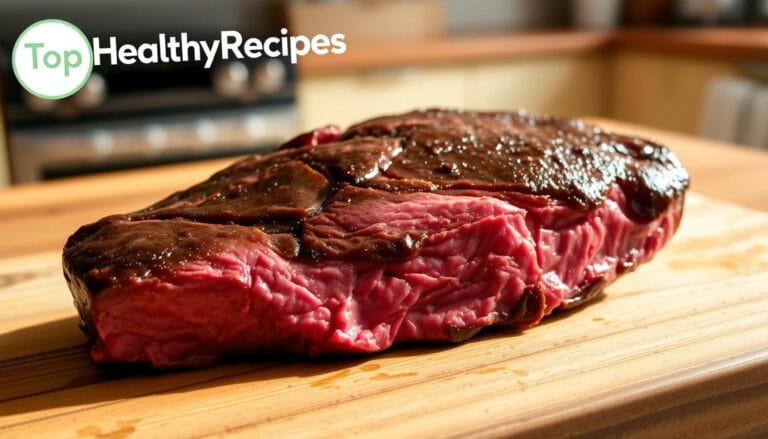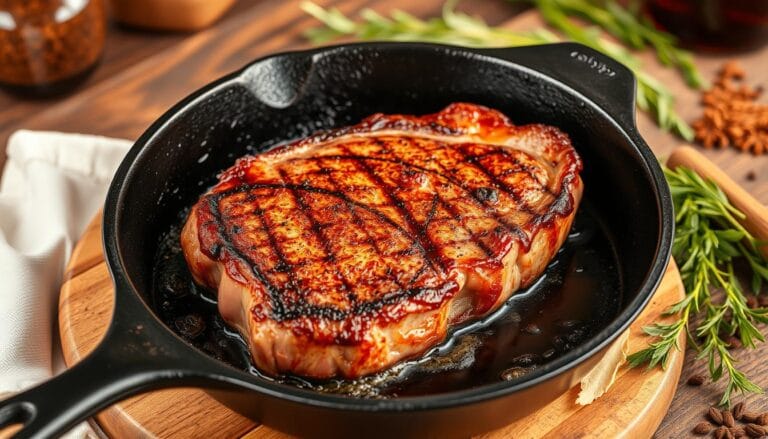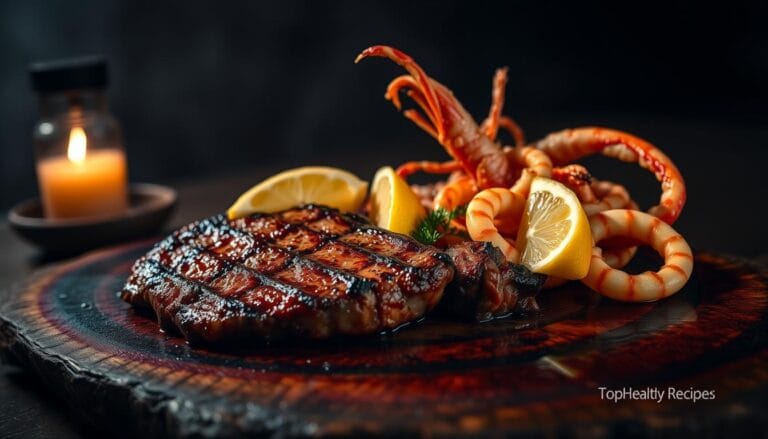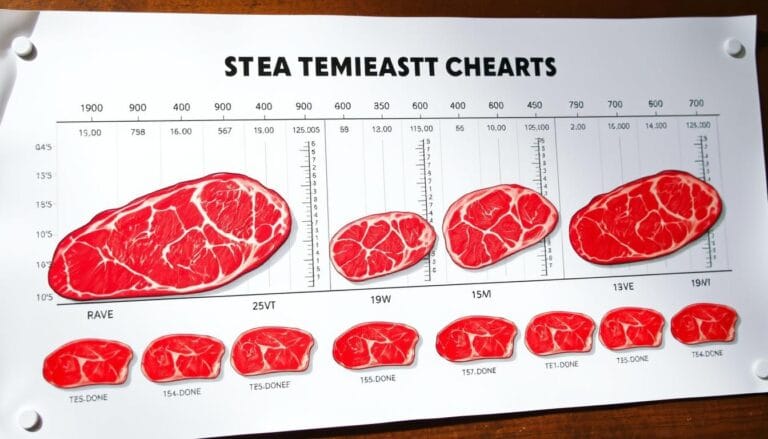Internal Temp Steak Guide: Cook Perfect Steaks Every Time
Table of Contents
Internal Temp Steak Guide: Cook Perfect Steaks Every Time
There’s nothing quite like biting into a perfectly cooked steak. The tenderness, flavor, and juiciness make it a special experience. But, getting it right can be tough, even for steak cooking beginners.
Cooking steak to the right internal temperature is key. It’s not just about what you like; different steaks need specific temperatures for the best taste. Knowing these temperatures and how to hit them is essential for great steaks.
In this guide, we’ll cover the science of cooking temperatures. We’ll also talk about the best temperatures for different steak cuts. Plus, we’ll share expert tips to make sure your steak is always perfect.
Key Takeaways
- Understand the importance of internal temperature for steak doneness.
- Learn the recommended internal temperatures for different steak cuts.
- Discover expert cooking techniques for achieving perfect steak.
- Explore various cooking methods and their impact on steak temperature.
- Master the art of cooking steak to your desired level of doneness.
Understanding Internal Temperature and Its Importance
The internal temperature of a steak is more than just a number; it’s the key to a perfect dining experience. It shows the heat at the steak’s center, telling you how done it is.
What Is Internal Temperature?
Internal temperature is key when cooking steak. It affects the steak’s texture, juiciness, and flavor. Heat moves from outside to inside as you cook, raising the internal temperature.
Proper temperature control is vital. It helps you get the steak just right, whether you like it rare, medium rare, or well done.
Why It Matters for Steak
Using internal temperature is more accurate than relying on looks or cooking time. The steak’s thickness and the heat source can change cooking times a lot.
“The only way to guarantee a perfectly cooked steak is to check its internal temperature.”
By focusing on internal temperature, you can make sure your steak is safe to eat. This reduces the risk of getting sick from food.
Common Myths About Cooking Temperatures
There are myths about steak temperatures, like thinking a steak keeps cooking after it’s off the heat. Or that poking it with a thermometer makes it lose juices.
- Myth: Steak continues cooking after being removed from heat.
- Myth: Using a thermometer causes significant juice loss.
Understanding the truth behind these myths can help you cook a steak perfectly.
Recommended Internal Temperatures for Different Cuts
Different steak cuts have unique characteristics. They need specific internal temperatures for the best flavor and texture. Knowing these differences is key to cooking steaks just right.
Ribeye
The ribeye is known for its rich marbling and tender texture. It’s best cooked to medium-rare (130-135°F) or medium (135-145°F). The high fat content makes it forgiving, but the right temperature brings out its natural flavors.
For those who prefer their steak more or less done, here are the guidelines:
- Rare: 120-130°F
- Medium-rare: 130-135°F
- Medium: 135-145°F
- Medium-well: 145-155°F
- Well-done: 155°F and above
Sirloin
Sirloin is a leaner cut that needs precise temperature control. Cooking it to medium-rare (130-135°F) or medium (135-145°F) keeps it juicy.
The recommended internal temperatures for sirloin are:
- Rare: 120-130°F
- Medium-rare: 130-135°F
- Medium: 135-145°F
- Medium-well: 145-155°F
- Well-done: 155°F and above
Filet Mignon
Filet mignon has low fat content. It’s best cooked to rare (125-130°F) or medium-rare (130-135°F). This preserves its tender texture and delicate flavor.
For filet mignon, the internal temperature guidelines are:
- Rare: 125-130°F
- Medium-rare: 130-135°F
- Medium: 135-140°F
- Medium-well: 140-145°F
- Well-done: 145°F and above
Flank Steak
Flank steak has a robust flavor and chewy texture. It’s best cooked to medium-rare (130-135°F) or medium (135-145°F). Remember to slice it against the grain after cooking.
The recommended internal temperatures for flank steak are:
- Rare: 120-130°F
- Medium-rare: 130-135°F
- Medium: 135-145°F
- Medium-well: 145-150°F
- Well-done: 150°F and above
By following these guidelines, you can achieve the perfect internal temp for steak regardless of the cut you’re cooking.
The Effects of Cooking Method on Internal Temperature
The way you cook your steak greatly affects its internal temperature. Different cooking methods can lead to different levels of doneness. This is true even if the cooking time seems the same.
Methods like grilling, pan-searing, sous vide, and oven roasting each have their own way of heating the steak. Knowing these differences is key to getting the internal temperature just right.
Grilling vs. Pan-Searing
Grilling and pan-searing use high heat to create a nice crust on the steak. But they heat the steak in different ways. Grilling uses radiant heat from below, while pan-searing uses direct contact heat.
Grilling heats the steak more evenly, but it can overcook the outside before the inside is done. Pan-searing creates a thick crust but needs careful attention to avoid burning.
| Cooking Method | Heat Application | Internal Temp Control |
|---|---|---|
| Grilling | Radiant heat | More even penetration |
| Pan-Searing | Direct contact heat | Risk of hot spots |
Sous Vide Cooking
Sous vide cooking seals the steak in a bag and cooks it in a water bath at a set temperature. This method ensures edge-to-edge doneness and avoids overcooking.
The water bath’s consistent temperature cooks the steak evenly. This means the internal temperature is exactly what you want.
Roasting in the Oven
Oven roasting can also achieve consistent internal temperatures, thanks to techniques like low-and-slow cooking.
Oven roasting uses dry heat that cooks the steak evenly. But getting a nice crust can be tricky without a high-heat sear.
By understanding how different cooking methods affect internal temperature, you can pick the best method for your steak. This way, you’ll always get the perfect doneness.
Essential Tools for Measuring Temperature
Measuring the internal temperature of steak is key. The right tools make a big difference. They help you cook your steak just right, whether you like it rare, medium rare, or well done.
Instant-Read Thermometers
Instant-read thermometers are loved by chefs and home cooks. They are fast and accurate. ThermoPop and Thermapen are top picks for quick checks.
To get an accurate reading, put the probe into the steak’s thickest part. Avoid fat or bone. This way, you get the internal temperature of steak right.
- Advantages: Quick and accurate readings
- Recommended Models: ThermoPop, Thermapen
- Proper Use: Insert into the thickest part of the steak
Probe Thermometers
Probe thermometers are great for watching your steak’s temperature. They’re perfect for grilling or roasting. You can keep an eye on the temperature without opening the grill or oven.
This is super useful for big steaks or when using the reverse sear method.
- Advantages: Continuous temperature monitoring
- Ideal Use: Grilling, roasting, and reverse sear method
Smartphone Thermometers
Smartphone-connected thermometers are a new way to check temperature. They offer cool features like temperature graphs, alerts, and cooking tips through apps. These tools make cooking better by giving you live data and insights.
- Advantages: Real-time data, temperature alerts
- Features: Temperature graphing, cooking guidance
It doesn’t matter which thermometer you pick. Make sure to calibrate it, know where to put it, and keep it clean. This way, you’ll always get your steak internal temp just right.
The Role of Carryover Cooking
When cooking steak, it’s key to know about carryover cooking. This is when food keeps cooking after it’s off the heat, thanks to leftover heat.
What Is Carryover Cooking?
Carryover cooking means a steak’s inside keeps getting hotter after it’s off the heat. This is because the outside is hotter, pushing heat into the inside.
How much carryover cooking happens depends on the steak’s thickness, the cooking temperature, and the method used.
How It Affects Final Temp
The inside of a steak can get 5-10°F hotter after it’s off the heat. For example, if you want a medium-rare steak at 130-135°F, take it off the heat at 120-125°F.
This trick is important to prevent overcooking. The rise in temperature can change based on the steak’s thickness and cooking method.
Adjusting for Carryover Cooking
To adjust for carryover cooking, follow these tips:
- For thinner steaks (less than 1 inch thick), remove from heat 5°F below the desired internal temperature.
- For thicker steaks (1-1.5 inches thick), remove from heat 10°F below the desired internal temperature.
- For grilling or pan-searing, the carryover effect is more pronounced due to the high heat.
- For sous vide cooking, the carryover effect is minimal because the steak is cooked at a consistent temperature.
By understanding and adjusting for carryover cooking, you can get the perfect steak done temp. This way, you’ll enjoy a steak that’s just right, with the right internal temp of steak.
Tips for Testing Doneness Without a Thermometer
Cooking the perfect steak doesn’t need a thermometer. You can use other ways to check if it’s done. These methods might not be as exact as a thermometer, but they’re useful when you don’t have one.
The Finger Test
The finger test lets you feel the steak’s firmness. It’s like comparing it to your palm. Touch your thumb to your index finger, then to your palm. This should feel soft, like a rare steak.
As you touch your thumb to other fingers, your palm will get firmer. This shows how done the steak is. This method takes practice, but it works well once you get it.
The Color Test
The color test looks at the steak’s color and juices. A rare steak has a red center and a warm red outside. As it cooks, the center turns less red, and the juices change color.
But, color alone isn’t always right. The steak’s thickness and cooking method can change its color.
The Time Test
The time test cooks the steak for a set time. For example, a 1-inch thick steak might cook for 3-4 minutes per side for medium-rare. But, this method isn’t always reliable.
It depends on the steak’s starting temperature and cooking method. Combining methods like the finger test and color test can help. This way, you get a better idea of the steak’s doneness.
Knowing the limits of each method is key. Things like steak thickness and cooking method affect the results.
As
“The art of cooking is not just about following a recipe; it’s about understanding the nuances that make a dish truly great.” – Jacques Pépin
, learning these methods can make you a better steak cook. You can get the perfect internal temp for steak without a thermometer.
Preparing Your Steak for Cooking
The journey to a perfectly cooked steak starts long before it hits the heat. Getting your steak ready right is key to the perfect steak done temperature. It makes for a great meal.
Let’s dive into the important steps for preparing your steak. These steps boost flavor and help control the internal temperature for steak.
Choosing Quality Cuts
Picking the right steak is the first step to a great meal. Look at marbling, color, thickness, and aging when choosing.
- Marbling: Choose steaks with good marbling for better flavor and tenderness.
- Color: A bright red color is best for most steaks.
- Thickness: Thicker steaks cook more evenly. Aim for 1-2 inches.
- Aging: Aging improves tenderness and flavor.
Seasoning Tips
Seasoning does more than add flavor; it also affects cooking. Here are some tips:
- Salt Timing: Salting just before cooking boosts flavor. But, dry brining 40+ minutes ahead keeps moisture.
- Other Seasonings: Use herbs and spices that match your steak’s natural taste.
- Application Method: Season evenly for consistent flavor.
Allowing Steak to Rest Before Cooking
Letting your steak come to room temperature before cooking helps it cook evenly. For a 1-2 inch steak, resting it 30-60 minutes at room temperature is key. It ensures even doneness from edge to center.
By following these steps, you’re on your way to a perfectly cooked steak. Enjoy a fantastic dining experience.
Cooking Techniques for Perfect Steak
Learning different cooking methods is key to getting the perfect steak. Each technique has its own benefits and challenges. They help you cook steak to your liking.
Reverse Searing
Reverse searing cooks the steak in a low oven (225-275°F) before searing it hot. This method offers exceptional temperature precision. It ensures even doneness throughout the steak. Here’s how to reverse sear:
- Preheat your oven to 225-275°F.
- Season the steak as desired.
- Place the steak on a wire rack over a rimmed baking sheet and cook until it reaches 10-15°F below your desired internal temperature.
- Sear the steak in a hot pan with oil until a crust forms.
This method works best for thicker steaks. It helps cook them evenly.
Direct Heat Methods
Direct heat methods, like grilling or pan-searing, cook the steak over high heat. They create a nice crust and cook the inside to your liking. To use direct heat effectively:
- Preheat your grill or pan to high heat.
- Sear the steak for 2-3 minutes per side, depending on the thickness and desired doneness.
- Use a thermometer to check the internal temperature, aiming for your desired doneness.
Managing the temperature gradient is key for even cooking.
Basting Techniques
Basting involves spooning hot butter and aromatics over the steak. It enhances flavor and promotes even cooking. To baste your steak:
- Melt butter in a pan and add aromatics like garlic or thyme.
- Once the steak is cooked to your desired level of doneness, tilt the pan and spoon the hot butter over the steak.
- Continue basting until the steak is coated and the internal temperature is even throughout.
Basting adds flavor and helps cook the steak evenly. It keeps the steak warm and even.
Mastering these techniques will help you cook the perfect steak. Whether you like the precision of reverse searing, the crust from direct heat, or the flavor from basting, there’s a method for you.
Resting Your Steak After Cooking
Once you’ve cooked your steak, it’s time to let it rest. This step is key to improving its quality. Resting helps the steak’s juices spread out evenly, making it tender and flavorful.
Crucial Reasons for Resting
Resting your steak is not optional; it’s essential. When you cook a steak, the heat tightens the proteins and pushes juices to the surface. Cutting into it right away lets these juices spill out, leaving your steak dry. By resting, the juices spread out, ensuring juicy and flavorful bites.
Key benefits of resting your steak include:
- Juice redistribution for a more flavorful steak
- More even internal temperature
- Improved texture, making the steak more tender
Recommended Resting Times
The resting time depends on the steak’s thickness and cooking method. Generally, rest a steak for 5-10 minutes. Thicker cuts or high-heat cooking may need up to 15-20 minutes.
Here are some guidelines for resting times based on steak thickness:
| Steak Thickness | Recommended Resting Time |
|---|---|
| 1-1.5 inches | 5-7 minutes |
| 1.5-2 inches | 7-10 minutes |
| Over 2 inches | 10-15 minutes or more |
How to Properly Rest a Steak
To rest your steak right, take it off the heat and put it on a wire rack or plate. You can cover it loosely with foil to keep it warm. But don’t wrap it too tight, as it might steam instead of rest.
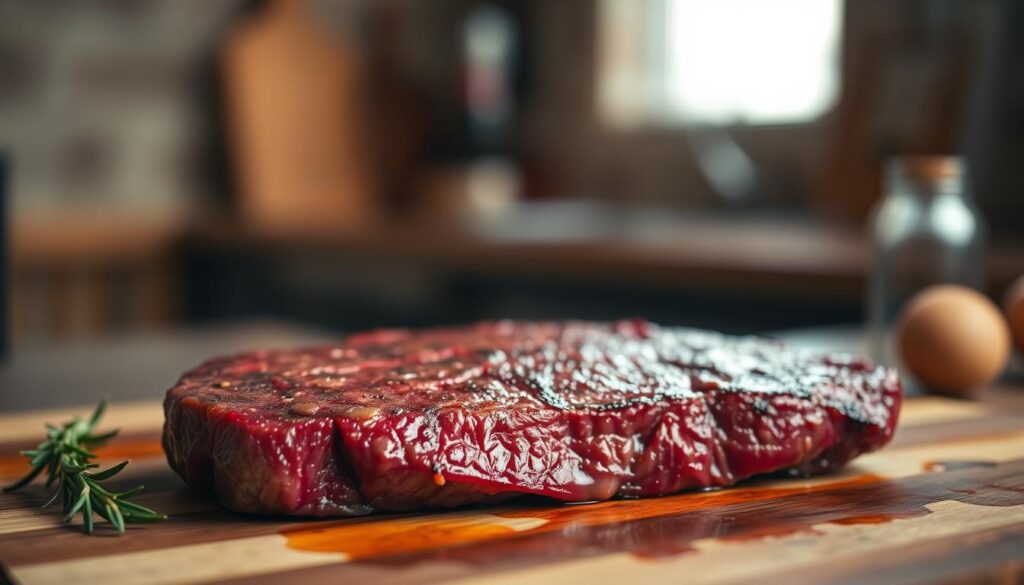
It’s also key to keep the steak’s temperature right during resting. A common worry is that it will cool down too much. To avoid this, rest the steak in a warm place or use a thermally insulated surface.
Mistakes to Avoid When Cooking Steak
Getting the perfect internal temperature for steak is key. But, it’s also vital to steer clear of common mistakes that can spoil your meal. Cooking steak is a delicate art, and several errors can result in disappointing outcomes.
Undercooking vs. Overcooking
Choosing the right doneness level is a big decision when cooking steak. Undercooking poses food safety risks, as it can contain harmful bacteria like Salmonella and E. coli. Overcooking, on the other hand, makes the steak dry and tough, losing its flavor. The best way to check the temperature is with a thermometer.
- Undercooking: Risks include foodborne illnesses.
- Overcooking: Leads to dryness and toughness.
Inconsistent Temperatures
Uneven cooking can happen due to hot spots on your grill or pan, or if the steak isn’t placed right. To avoid this, make sure your cooking area is evenly heated. Also, try flipping the steak a few times to cook it evenly.
Ignoring Resting Time
Resting your steak after cooking is essential. It allows juices to spread, making the steak tender and flavorful. Skipping this step can make your meal less enjoyable. The resting time depends on the steak’s size and thickness, but 5 to 10 minutes is a good starting point.
Other mistakes include not using thermometers correctly, cooking steaks straight from the fridge, and relying only on cooking times. Knowing these common errors helps you avoid them. This way, you can always achieve the perfect internal temperature for a deliciously cooked steak.
Pairing Internal Temp With Desired Outcomes
Steak’s internal temperature is more than a number; it shapes your eating experience. It affects the steak’s texture, juiciness, and taste. Knowing how to match internal temperature with your desired steak is key to perfection.
Juiciness vs. Firmness
The steak’s internal temperature greatly influences its juiciness and firmness. As the temperature goes up, the steak loses moisture, making it less juicy. For example:
- Lower temperatures (Rare: 120°F – 130°F) keep more juices, making the steak juicier.
- Higher temperatures (Well Done: 160°F – 170°F) make the steak drier and firmer.
The steak’s protein structure changes with temperature, affecting its texture and feel. At lower temperatures, the steak is more tender. As temperatures increase, the steak becomes firmer.
Flavor Variations at Different Temps
Different internal temperatures change the steak’s texture and flavor. Lower temperatures keep the natural beef taste, while higher temperatures create complex flavors through the Maillard reaction.
For example:
- Cooking steak to a lower internal temperature (Rare or Medium Rare) keeps its natural flavors.
- Cooking to higher temperatures (Medium or Well Done) develops more complex flavors due to the Maillard reaction.
Customizing for Personal Preference
Customizing your steak’s internal temperature is an art. Try different temperatures in 5°F increments to find your ideal doneness. Consider the steak’s cut, fat content, and your eating preference when adjusting temperatures.
Fattier cuts like ribeye benefit from higher temperatures to melt the fat. Leaner cuts like sirloin are better at lower temperatures to stay juicy.
- Start by identifying your preferred level of doneness.
- Adjust the internal temperature based on the steak type.
- Experiment with different temperatures to find your perfect balance between juiciness, firmness, and flavor.
Seasoning and Marinades Affecting Temperature
Seasonings and marinades play a big role in cooking a steak. They can change how the steak cooks. Knowing how they affect temperature helps you cook it just right.
How Marinades Change Cooking Time
Marinades, like those with vinegar or citrus, can make the steak cook faster. But, it’s important to watch the temperature closely. The steak might cook quicker than you think.
Acidic marinades make the steak tender but can cook it faster on the outside. To prevent overcooking, check the temperature often, even with highly acidic marinades.
Salt and Its Impact on Temp
When you salt the steak can change how it cooks. Salting right before cooking is different from dry brining, where you apply salt hours ahead.
Dry brining lets salt go deeper into the meat. This can make the steak cook more evenly. It also changes how you manage the temperature while cooking.
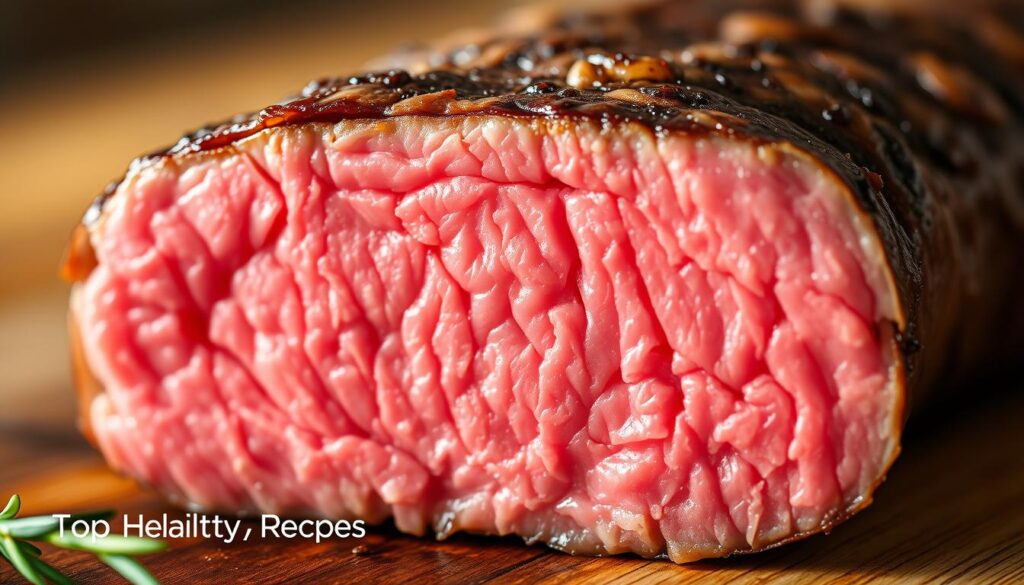
Spice Variations and Cooking Techniques
Spices and how you use them can also affect cooking. Some spices burn easily at high heat. You might need to adjust your cooking to avoid charring and reach the right temperature.
Spice crusts or oil-based marinades can slow cooking. Knowing this helps you adjust to get the steak just right.
Sugars in marinades can make the outside brown fast. This means you need to adjust your cooking to balance browning and temperature.
The Science Behind Steak Cooking
Learning about the science of steak cooking can make you a better griller. It helps you get the steak’s internal temperature just right. This involves complex chemical reactions and how heat moves, which greatly affects the steak’s taste and texture.
Maillard Reaction Explained
The Maillard reaction happens when food cooks, mixing amino acids and sugars. This creates new flavors and browns the food. It’s key for a steak’s taste and crust.
“The Maillard reaction is a non-enzymatic browning reaction between amino acids and reducing sugars that results in the formation of new flavor compounds and browning.” –
To get the most from the Maillard reaction, cook your steak at the right temperature. Also, make sure it’s dry on the outside.
Heat Transfer in Cooking
Heat transfer is vital when cooking steak. There are three main ways: conduction, convection, and radiation.
- Conduction happens when heat goes straight from the cooking surface to the steak.
- Convection uses a fluid, like air or water, to transfer heat.
- Radiation uses electromagnetic waves to transfer heat.
| Cooking Method | Primary Heat Transfer Method | Effect on Steak |
|---|---|---|
| Grilling | Radiation | Creates a charred crust |
| Pan-Searing | Conduction | Develops a crispy crust |
| Oven Roasting | Convection | Evenly cooks the steak |
The Role of Fat in Temperature Management
Fat is important in cooking steak. It affects the steak’s internal temperature and taste. The fat inside the steak, called marbling, helps keep it warm longer.
The fat in the steak can change how long it cooks and how steady the temperature stays. Knowing how fat affects heat can help you cook the steak more evenly.
By understanding these scientific principles, you can improve your steak cooking. This way, you’ll get the perfect internal temperature every time.
Final Thoughts on Achieving the Perfect Steak
As you keep cooking steaks, remember it’s a mix of science, skill, and taste. You’ve learned a lot, but the real skill comes from trying new things. Practice and experiment to get better.
Recap of Important Temperature Guidelines
Let’s go over the key temperature tips. Different steaks need different internal temperatures. For example, a rare ribeye should be 120°F – 130°F. A well-done sirloin needs to be 160°F or more. Check the temperature chart from earlier for more details.
Experimenting with Techniques
Getting the perfect steak is more than just following rules. It’s also about trying new ways to cook. Try grilling, pan-searing, or sous vide to see how they change your steak.
Continuous Learning in Steak Cooking
Getting better at steak temperature is a lifelong process. Keep a cooking journal to track your progress. This will help you improve your skills and adapt to new situations. Trust your thermometer and listen to your instincts for the best results.
Resources for Further Learning
To keep improving your steak temperature skills, check out these resources. Cookbooks like “The Food Lab” by J. Kenji López-Alt and “Meathead” by Meathead Goldwyn are great. They offer deep insights into cooking the perfect steak.
“Salt Fat Acid Heat” by Samin Nosrat is another excellent choice. It helps you understand how to get your steak just right.
Cookbooks and Online Courses
Online courses from MasterClass and America’s Test Kitchen teach you a lot about steak temperatures. You can also visit tophealtyrecipes.com for more cooking tips. These can help you get your steak to the perfect temperature.
Helpful Cooking Resources
Online sites like Serious Eats, Amazing Ribs, and Thermoworks Blog are full of useful info. They offer science-backed cooking tips and guides on temperatures. Watching YouTube cooking channels and joining forums can also be helpful.
They let you share your experiences and get help with any temperature problems you might have.
FAQ
What is the ideal internal temperature for a perfectly cooked steak?
How do I measure the internal temperature of a steak?
What is carryover cooking, and how does it affect my steak?
Can I cook steak without a thermometer?
How do different cooking methods affect the internal temperature of steak?
What is the recommended internal temperature for different types of steak?
How does the thickness of a steak affect its internal temperature?
Can I use a thermometer to check the internal temperature of a steak while it’s cooking?
How do I adjust for carryover cooking when cooking steak?
What are some common mistakes to avoid when cooking steak to the right internal temperature?
For more cooking tips, stay connected with us. We also recommend the cookbook Skinnytaste Simple: Easy, Healthy Recipes with 7 Ingredients or Fewer
For more Recipes about Steak ?
Did You try our recipe ?
There are no reviews yet. Be the first one to write one.
